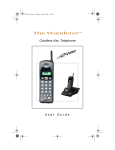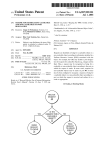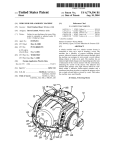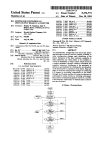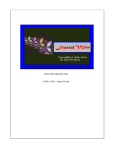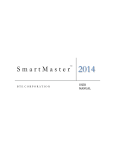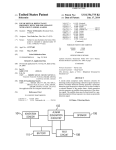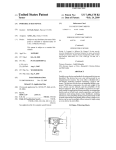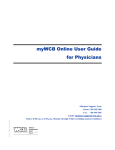Download i Compression i
Transcript
US006505208B1 (12) United States Patent (10) Patent N0.: (45) Date of Patent: Kanevsky et al. (54) (74) Attorney, Agent, or Firm—Scully, Scott, Murphy & Presser; Daniel P. Morris, Esq. (75) Inventors: Dimitri Kanevsky, Ossining, NY (US); Alexander Zlatsin, Yorktown Heights, (57) NY (US); Cli?'ord Alan Pickover, Yorktown Heights, NY (US) N' ot1ce: The educational system recommends to users, a most ef? International Business Machines Sbj u ect to an yd'l' 1sc a1mer, t h e term 0 fh' t is patent is extended or adjusted under 35 devices distributed over a netWork in an attempt to achieve a certain goal. The command sequences are segmented, each segment is labeled With a goal identifying purpose mark, a cost of each segment is computed. The detected command sequences are then compared With the command sequences detected previously and the descriptions of the more ef?cient U.S.C. 154(b) by 0 days. (21) Appl. No.: 09/329,128 Jun. 9, 1999 (22) Filed: (51) Int. Cl.7 .............................................. .. G06F 17/30 (52) US. Cl. ..................................................... .. 707/102 (58) Field of Search ................. .. 434/1—432; 707/1—100 References Cited (56) command sequences are provided to the users utilizing the less effective approaches. The detected command sequence is stored in place of less ef?cient of the command sequences and Where no prior command sequences has been previously stored. U.S. PATENT DOCUMENTS 5,909,589 A * 6/1999 ABSTRACT cient manner of accomplishing tasks achievable by comput ing devices. The system detects command sequences executed by users during an interaction With computing Corporation, Armonk, NY (US) * Jan. 7, 2003 Primary Examiner—Diane D. MiZrahi Assistant Examiner—Apu M Mo?Z EDUCATIONAL MONITORING METHOD AND SYSTEM FOR IMPROVING INTERACTIVE SKILLS BASED ON PARTICIPANTS ON THE NETWORK (73) Assignee: US 6,505,208 B1 Parker et a1. ............... .. 712/32 * cited by examiner 35 Claims, 5 Drawing Sheets 820 81 2 Analyzer Module 3 Segmentation of user actions 83,0 _ i i Compression i i 3 t Classification is» 82 E i l r cost of segments 8520 , i l 5 Storage :L 5 l Evaluating a 8130 of cost Indexing i Labeling COmPEFiHQ 5 l 5 J: Open close windows; file; turn on/off controller I l Goals 1 5 purpose i I l 831 I lL __________________________ marks storage “J Database of segments costs U.S. Patent Jan. 7, 2003 Sheet 4 0f 5 US 6,505,208 B1 820 2 Get action segment 840 / Evaluate cost 851 ) Compare with cost in storage 852 1 Store this action segment if it is the box 8255 Database 853 x Inform a user about different action segment if it is more efficient Fig. 4 U.S. Patent Jan. 7, 2003 Sheet 5 0f 5 ANALYZE Collected data is analyzed base on application event patterns in various conditions as user actions; SEGMENTIZE User actions are separated into segments; LABEL Label each user action segment with a purpose mark containing the reason for the action. EVALUATE Evaluate cost of each user action. COMPARE Compare archived actions with the current. ADVISE Advise a user about availability of a more efficient action; and RECORD Record the more efficient action in the database. Fig. 5 US 6,505,208 B1 US 6,505,208 B1 1 2 EDUCATIONAL MONITORING METHOD AND SYSTEM FOR IMPROVING INTERACTIVE SKILLS BASED ON PARTICIPANTS ON THE NETWORK System”, ?led on May 14, 1998, the Whole contents disclo sure of Which are incorporated herein by reference. A counting module is used to split user actions into sub-steps, classify these sub steps, and to measure complexity of actions in terms of the complexity of chains of the sub step classes. For example, a value one (1) may be assigned to BACKGROUND OF THE INVENTION such steps as clicking a mouse button, hitting a key on a keyboard etc., thus a complexity of a user action to open 1. Field of the Invention some ?le Would be a number of hits and clicking that a user The invention relates to education and guidance of users 10 spent to ?nd and open a ?le. of computing devices, and more speci?cally to an automatic As an example, please consider a situation Where tWo comparison and evaluation of methods folloWed by various users of an identical system are performing a ?le open users to ful?ll an identical goal and the determination of command. One user may type a name of the ?le to open it, most effective method. another user may ?nd the name of the ?le in a special 2. Description of Prior Art 15 WindoW and click on it. Based on the evaluation described With the advent of computers and embedded devices and above, if the system determines that the second user is more the incredible groWth of the number of personal computer ef?cient, the ?rst user Will be noti?ed and/or guided through users, it is becoming increasingly more dif?cult to teach users the most ef?cient Ways of interacting With the softWare the more ef?cient steps to take for achieving the ?le open. The noti?cation and guidance may be in a form of a pop-up menu displayed on the ?rst user’s screen and describing the steps as taken by the second user. The noti?cation and guidance also may include one or more graphical feedbacks such as highlighting of icons, menu tool bars, and other WindoW objects to guide the ?rst user to the optimal steps. applications running on the various hardWare platforms. Currently, to familiarize themselves With the Workings of 20 the application components, the computer users may read an invariably Weighty User’s Manual book, purchase and vieW a videotape on the subject, take a class, or as commonly done, simply start using the application referring to the application’s Help subsystem When necessary. 25 The strings of actions having least complexity are then stored in a central educational database, and are used as referenced prototypes for comparison With other user actions. If the same operation is later determined to be performed more ef?ciently, the neW, more ef?cient string of actions is then stored in a database. Furthermore, the refer enced prototype of string actions may be introduced in the None of the instances above, are guaranteed to teach a novice or an expert user the most optimal sequence of steps to perform a task. Additionally, considering the sheer vol ume of neW and presently used computer applications being offered for sale and use, i.e., over Internet, every month, a Way is needed to teach the users hoW to operate those database by the human experts. applications. BRIEF DESCRIPTION OF DRAWINGS What is needed is a system to inform computer users of 35 the most efficient Way to perform individual application tasks and functions. The foregoing objects and advantages of the present invention may be more readily understood by one skilled in the art With reference being had to the folloWing detailed SUMMARY OF THE INVENTION The inventive educational system monitors all user description of a preferred embodiment thereof, taken in 40 actions When they interact With applications being executed conjunction With the accompanying draWings Wherein like elements are designated by identical reference numerals throughout the several vieWs, and in Which: on devices such as personal computers, laptop, palmtops, controllers, telephones, etc. The system measures and com putes the number of steps or actions that are applied by the user to achieve some result, such as mouse clicks and 45 keyboard strokes used for ?nding and opening of ?les, sending of an email, a broadcast message and for telephone dialing to connect to Internet or to talk to a person. Additionally, other factors such as the amount of distance a mouse Was dragged in a step, a type of input entry in the step 50 taken, e.g., mouse click, keyboard entry, and/or pull doWn FIG. 1 is the overvieW of a netWork layout of the present invention. FIG. 2 is a ?oWchart of logical steps of the analyZing part of the present invention. FIG. 3 is a logical representation of the cost of segment evaluation. FIG. 4 is a logical representation of the cost comparison betWeen a determined and a previously stored action seg menu selection are considered in computing the most opti mal sequence of steps for performing a task. The computa ments. tions are then stored, for example on a disk or in memory of invention for learning the optimal action and educating the the device. The stored results are compared to those of other users, to determine Whether different users are applying different number and types of actions to achieve the same goal, e.g., opening a ?le. From each of the results, a most optimal approach is determined and a description of the most opti mal approach is then sent to the less skillful users. FIG. 5 is a ?oWchart of logical steps of the present 55 user. DETAILED DESCRIPTION OF THE INVENTION The inventive educational system, shoWn in FIG. 1, is 60 distributed over a netWork 10 of computing devices such as The inventive educational monitoring system interprets all types of computers 20, traditional, cellular and digital phones 30, palmtop computers 40, and other household user actions and ascertains, When identical tasks are per formed by users through the use of a semantic module record, tape and CD players, radios, clocks, Watches, pens, described in a commonly oWned, co-pending US. patent appliances With imbedded controllers, such as televisions, 65 refrigerators, stoves microWave ovens etc. The netWork of application Ser. No. 09/078,807 now US. Pat. No. 6,236, the present invention may consist of homogenous netWorks 968, entitled “Sleep Prevention Dialogue Based Car e.g., Internet, Extranet, Intranet, LAN, telephone netWork, US 6,505,208 B1 3 4 wireless network, satellite network, infrared network, as medium. The medium may include speech, typing, making well as any combination thereof. gestures, or moving of the computer mouse. The user The system may employ visual 50, audio 60 touch sen sitive 70, as well as infrared, heat, and power on/off switch components having software sensors for detecting user actions, when any user interacts with any of the distributed computing devices, are provided. User actions may include voice commands, gestures, computer mouse clicks, com starting to speak, moving of the mouse, making gestures, typing is the beginning of medium. The user action segments are then indexed, compressed, classi?ed and stored, as described in the above referenced US. patent application Ser. No. 09/079,754, by module 82 (FIG. 2) and data from different users is compared at step 850 (FIG. 2). The comparison of data may involve the puter keyboard strokes, touch-sensitive device touches and other. 10 The data collected by sensors and collected at a server 80 is then analyZed by module 81. FIG. 2 shows the workings of the analyZe module 81. First, the user actions needed to achieve some goal are segmented at step 820 into user action segments. Each user actions segment is then labeled at step ments may be from the same user performing the same command differently at different times, or from different 15 users. 830 with a purpose mark to denote one or several reasons for a user to perform this particular action. A stored list of purpose marks 831 contains the reasons for the user per formed actions including: opening a terminal window, open ing a ?le, closing a ?le, executing icons, performing searches, executing operating system or application commands, turning off devices, ?nding a network channel, activating some command sequences to perform user action sequences. In FIG. 3, the cost of each user action segment is 20 FIG. 4 shows the How of the prototyping and retrieval steps of the present invention. After determining the user action segment at step 820 and evaluating its cost at step 840, the user action segment is matched with the previously stored action segment at step 851. All user action segments produced at any time are compared with the stored segment action. At step 852, if the new user segment action is determined to be more ef?cient then the stored ones, the new user segment action is stored in place of the old. If a user 25 segment action having the same purpose mark, was never before performed and stored, the present user segment action computed at step 840 by using a counter 845 and estimating for example the complexity, length of the segment, amount of distance a mouse is dragged, a type of input entry such as a key press or mouse click, and the number of action units into which the action segment may be split. The cost of an action segment may be estimated as the complexity or comparison of the purpose mark labels for different action segments and the comparison of cost of action segments having the same purpose marks. The compared action seg is stored in a database 855. The user segment action may also be pre-loaded in a database 855 by application experts. 30 If a determination is made, at step 853, that the action segment retrieved from the database 855, has less cost than the action segment produced by the target user, the descrip tion of the more efficient action may be sent to that target duration of the segment, and the number of action units into user. The description sent, may be displayed on the user which this action segment may be split. terminal and played back over the user’s device’s audio Action units may be keystrokes, 841, words or phonetic 35 means for example. groups in a spoken phrase 842, elementary gestures 843 such A classi?cation of the user actions may be performed by as those described in a commonly owned, co-pending US. patent application Ser. No. 09/079,754 now US. Pat. No. 6,421,453, entitled “Apparatus And Methods For User Rec an interpreter module 83 (FIG. 1) having an ability to 15, 1998, the whole contents disclosure of which are incor understand the meaning of the user action segments. The interpretation module may include a semantic module, as described in the above referenced US. patent application Ser. No. 09/078,807, now US. Pat. No. 6,236,968 having an porated herein by reference, and the elementary user func tions 844 including Zooming in on an icon, displaying ability to understand the meaning of phrases typed in or spoken and of gestured. All action segments having the same ognition Employing Behavioral Passwords”, ?led on May top-down/up menus, opening and closing ?les, editing functions, making graphic facilities functions, and drawing 40 goal or the same semantic meaning are classi?ed into one 45 a geometric ?gure. For example, a ?le open may contain the following action units: 1. Click on a WordPro icon; OUI-PWN user is then noti?ed if there are simpler or alternative . Click to select “SmartMaster”; approaches for accomplishing the same task. The initial steps or recipes may be created and stored in the database by monitoring experts experienced in the use of the software. As shown in FIG. 5, the collected data is analyZed based on application event patterns in various conditions and grouped . Click OK; . Click “File Open”; . Click to select a ?le name; and . Click on “Open”. Furthermore, action units may constitute pressing a 55 label step 3, each user action segment is labeled with a purpose mark containing the reason for the action. The step 4 evaluates cost of each user action and at step 5, the sounds spoken into a audio input apparatus, a sequence of gestures made into a camera and movements and clicks of a 60 action segment is a ?rst event necessary to start a given segment action leading to the segment action goal. The ?rst event for the given segment action is started when the end of the previous segment action is reached, it is the onset of a moment when the user turns on or starts to operate in some into user actions at the analyZe step 1. The user actions are then separated segments at the segmentiZe step 2. At the sequence of keys on a keyboard, a selection of buttons on an input device or positions on a touch screen, a sequence of computer mouse. Each action segment is comprised of a beginning and an end. The end of the action segment is the event of the user goal achievement. The beginning of the class. When users attempt to achieve a task using any of the devices connected to the inventive system, the system com pares the steps followed with those saved in the database. A 65 archived actions are compared with the current user action. At step 6 the user is advised about the availability of a more ef?cient action, and at step 7 the more ef?cient action is recorded in the database. In one embodiment, the inventive system may change the graphical characteristics of icons, windows, menu items, and the like, to guide the user through ef?cient or alternate means of accomplishing a task. For example, if the system has US 6,505,208 B1 6 5 determined that the task may be accomplished by selecting icon A, followed by menu item B, the system may highlight detecting actions executed by each of said users during their interaction With said computing devices to achieve icon A and then menu item B. one of said tasks; comparing said actions With other actions of other users accomplishing identical tasks to determine said most In another embodiment, the inventive system may use speech synthesis or pop-up WindoWs to guide the user, e.g., efficient technique; and as a user moves a cursor in the vicinity of certain icons, the system may inform the user Where those icons are located providing said users With descriptions of said most ef? and may also articulate What they do. For example, Where the inventive system suggests a certain approach, i.e., select ing a certain icon at a particular point during the execution 2. The method of claim 1, Wherein said netWork is cient technique. 10 Internet. 3. The method of claim 1, Wherein said detecting step is performed by sensors. of a program, as the user searches for the correct icon and the cursor is Within a certain radius of the icon the invention 4. The method of claim 1, Wherein said tasks include one may sound an announcement, such as, “to select the icon, or more selected from the group consisting of: opening a please move the cursor up and to the left.” The user moving WindoW; opening a ?le; closing a ?le; executing an icon; the cursor toWards a group of icons suggests to the inventive 15 searching performance; executing a command; sWitching off system that the user is interested in making a certain a device; ?nding a channel; and condition activation. selection and hence is a good cue that an announcement may 5. The method of claim 4, Wherein said actions include be helpful. one or more selected from the group consisting of: pressing The announcing feature may also be sWitched off as a user keyboard keys, clicking mouse buttons, touching touch option. In determining Which icons should be self announc ing the invention may use techniques for analyZing the nearest neighbor problems, Where all the distances from the sensitive components of said computing devices, voice commands, physical gestures, computer application operations, and appliance operations. cursor to all the icons are computed and sorted. Round robin methods may also be applicable so that multiple icons may be announced in turn. Simple arti?cial intelligence schemes based on prior usage or based on a particular application 6. The method of claim 5, Wherein said actions comprise one or more action units selected from the group consisting 25 of: a set of keystrokes, a set of mouse movements and clicks, a set of touches of a touch sensitive device, spoken Words may determine Which of several nearby neighbor icons should be announced. For example, if a recipe suggests that and phrases, sounds in a spoken phrase, elementary gestures, and elementary user functions comprising Zooming an icon, icon B is likely to be used after icon A, than icon B Will be announced When the cursor is in its vicinity. The threshold displaying a menu, closing ?les, editing functions, executing graphic facilities functions, and draWing geometric ?gures. distance may be changed to suit a particular user, or a class of users, needs, or may be dynamically altered based on 7. The method of claim 6, Wherein said detecting step further comprises the steps of: arti?cial intelligence methods. indexing and classifying said actions; As an aid to the user, an announced or talking icon may give a simultaneous indication of its presence by moving lips on the body of the icon. The lips may actually move according to the simultaneous speech so that lip-readers can take advantage of it. The language of the user’s choice may be selected. This, announcing aspect of the invention may have a special value for the blind, visually impaired or illiterate adults and children. The announcing steps to 35 8. The method of claim 7, Wherein said computing step computes complexity, string length of said actions, a number of said action units, and time duration of said actions. 9. The method of claim 8, Wherein said comparing step comprises the steps of: comparing said purpose identi?er; and achieve a certain action may include a closed captioning system making this invention applicable for the deaf, as Well as in multimedia applications, museum and shopping mall kiosks, video games, etc. The present invention may be applied to text processors, art programs Internet, etc. In the virtual reality systems, the if said purpose identi?er matches, comparing said cost. 10. The method of claim 9, Wherein each of said actions 45 to accomplish a task. Additionally, the list of recipes may be categoriZed and sorted according to the age of the user, geographical location, skill of the user, date of entry, version of softWare, and other criteria. The database containing recipes may be stored in a proprietary format and accessed operating. 12. The method of claim 9 Wherein said actions are saved in a database of said most ef?cient actions if they are more over a netWork. Having thus described our invention, What We claim as neW, and desire to secure by Letters Patent is: 1. An educational method for recommending to users a most ef?cient technique of accomplishing tasks achievable by computing devices distributed over a netWork, said method comprising the steps of: includes a beginning of segment to indicate a ?rst event leading to said task and an end of segment to indicate the achievement of said task. 11. The method of claim 10, Wherein said ?rst event starts When said end of segment of a previous of said actions is reached and When said computing devices are caused to start user may be alerted to a suggestion of a more ef?cient recipe While the invention has been particularly shoWn and described With respect to illustrative and preferred embodi ments thereof, it Will be understood by those skilled in the art that the foregoing and other changes in form and details may be made therein Without departing from the spirit and scope of the invention that should be limited only by the scope of the appended claims. labeling each of said actions With a purpose identi?er; and computing a cost for each of said actions. 55 ef?cient than said other actions having the same purpose identi?er, and if no other actions having the same purpose identi?er exist in said database. 13. The method of claim 12, Wherein said actions are entered and modi?ed by an expert and saved in said data base. 14. The method of claim 13, Wherein said providing step displays said descriptions of said most efficient technique to said users. 15. The method of claim 14, Wherein a description of steps for said most ef?cient technique is provided When said 65 users attempt to execute said actions. 16. A computer program storage device readable by a machine, tangibly embodying a program of instructions US 6,505,208 B1 8 7 executable by a machine to perform method steps for 26. The computer program device of claim 25, Wherein plishing tasks achievable by computing devices distributed said ?rst event starts When said end of segment of a previous of said actions is reached and When said computing devices over a network, said method comprising the steps of: are caused to start operating. recommending to users a most efficient technique of accom 27. The computer program device of claim 26 Wherein detecting actions executed by each of said users during 5 said actions are saved in a database of said most ef?cient their interaction With said computing devices to achieve actions if they are more efficient than said other actions having the same purpose identi?er, and if no other actions having the same purpose identi?er exist in said database. one of said tasks; comparing said actions With other actions of other users accomplishing identical tasks to determine said most ef?cient technique; and 10 providing said users With descriptions of said most ef? cient technique. 17. The computer program device of claim 16, Wherein said netWork is Internet. 18. The computer program device of claim 16, Wherein 29. The computer program device of claim 28, Wherein said providing step displays said descriptions of said most 15 said detecting step is performed by sensors. 19. The computer program device of claim 16, Wherein provided When said users attempt to execute said actions. consisting of: opening a WindoW; opening a ?le; closing a 31. The computer program device of claim 23, Wherein said computing step further computes an amount of distance ?le; executing an icon; searching performance; executing a command; sWitching off a device; ?nding a channel; and a mouse is dragged. condition activation. 20. The computer program device of claim 19, Wherein consisting of: pressing keyboard keys, clicking mouse ef?cient technique on said users’ terminal and plays over speakers of a user computing device. 30. The computer program device of claim 29, Wherein a description of steps for said most ef?cient technique is said tasks include one or more selected from the group said actions include one or more selected from the group 28. The computer program device of claim 27, Wherein said actions are entered and modi?ed by an expert and saved in said database. 32. The computer program device of claim 23, Wherein said computing step further computes a type of input entry. 25 33. An educational system for recommending to users a most ef?cient technique of accomplishing tasks achievable by computing devices distributed over a netWork, said buttons, touching touch-sensitive components of said com puting devices, voice commands, physical gestures, com system comprising: puter application operations, and appliance operations. means for detecting actions executed by each of said users 21. The computer program device of claim 20, Wherein during their interaction With said computing devices in said actions comprise one or more action units selected from the group consisting of: a set of keystrokes, a set of mouse movements and clicks, a set of touches of a touch sensitive an attempt to achieve one of said tasks; device, spoken Words and phrases, sounds in a spoken phrase, elementary gestures, and elementary user functions comprising Zooming an icon, displaying a menu, closing means for comparing said actions With other actions of other users accomplishing identical tasks to determine said most efficient technique; and means for providing said users With descriptions of said ?les, editing functions, executing graphic facilities functions, and draWing geometric ?gures. most ef?cient technique. 34. The system of claim 33, Wherein said means for detecting comprises: 22. The computer program device of claim 21, Wherein said detecting step further comprises the steps of: indexing and classifying said actions; 40 identi?er; labeling each of said actions With a purpose identi?er; and computing a cost for each of said actions. means for computing a cost for each of said action segments; and 23. The computer program device of claim 22, Wherein said computing step computes complexity, string length of said actions, a number of said action units, and time duration of said actions. 24. The computer program device of claim 23, Wherein said comparing step comprises the steps of: comparing said purpose identi?er; and if said purpose identi?er matches, comparing said cost. 25. The computer program device of claim 24, Wherein each of said actions includes a beginning of segment to indicate a ?rst event leading to said task and an end of segment to indicate the achievement of said task. means for indexing and classifying said actions; means for labeling each of said actions With a purpose 45 means for saving said actions in a database if they are more ef?cient than said other actions having the same purpose identi?er, and if no other actions having the same purpose identi?er exist in said database. 35. The system of claim 34, Wherein said means for comparing comprises: means for comparing said purpose identi?er; and means for comparing said cost if said purpose identi?er matches.










